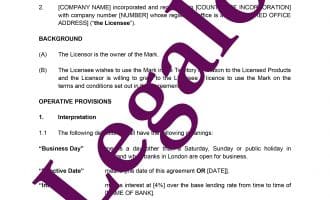Trademark Licence
Our Trademark Licence Template:
- UK-solicitor-drafted template for reliability
- Full guidance notes included
- Cost-effective legal certainty
- Money-back satisfaction guarantee

How Does It Work?
-
1. Download
-
2. Edit
-
3. Print
-
4. Sign
You may at some time need to have a Trademark Licence template, so that you can let a third party use your trademark. In the UK by law a licence of a trademark must be in writing. We have had this Trademark Licence drafted by an experienced UK lawyer. Therefore you can be sure that it complies with the laws of England and Wales.
Trademark Licences
Your trademark is one of the more valuable assets that your business contains. When you use this Trademark Licence, you can give your permission for the trademark to be licensed. Using our draft, you can:
- easily control the way the trademark is used; and
- set out the specified term of the licence.
Whether your Trademark is registered or not, you can still license others to use it. If you have not considered registering your Trademark, you should do so. If registering it, you need to do so at the IPO’s website here. A registered trademark gives you greater protection and is easier to enforce.
If instead of licensing its use, you want to sell it, then use our Trademark Assignment to do so.
If you need a more general licence for various types of intellectual property, not just for trademarks, then try our Intellectual Property Licence.
Using our Trademark Licence template
It is very easy to use and can be customised for your specific needs. After you have bought the template, you will be able to download it in Word. Once you have it on your computer you will be able to reuse the document whenever you need it again. Should anything change with the UK laws affecting this template, you will receive all updates to it at no additional cost.

Guide to our Trademark Licence template
Below you will see an excerpt from the guide to this template. You receive the full guide when you buy the draft.
Our Trademark Licence is for use by a trademark owner (called the licensor) who is wishing to give permission to someone else to use the trademark (called the licensee). It provides for the owner to give such permission in return for a payment of a royalty by the licensee on sales made by the licensee using the trademark. (You would need to decide how much royalty should be charged and we cannot guide you on that. It can depend on what prestige is attached to the trademark/brand and what premium can therefore be charged on products bearing that brand.)
This licence incorporates various options, so it is appropriate whether:
- there are one or more trademarks to be licensed;
- the trademark(s) is/are registered or unregistered; or
- the licensee is to use the trademark(s) for the sale of goods or services (or both).
Competition laws and trademark licences
This trademark licence complies with UK law, including EU competition laws, as at the date it was written. If you are adapting our draft, be careful not to put further restrictions on the licensee that might infringe competition laws. See our brief notes on this in the context of clause 2.3 below.
Clauses in this Trademark Licence template
1. Interpretation
This clause defines the main terms used in the licence.
- Business Day – a simple definition.
- Effective Date – the start date for the agreement. Ideally the date should not be one in the past.
- Interest – Fill in (a) the percentage over the base rate for the interest you would charge on late payments, and (b) the bank whose base rate this will follow (e.g. the Bank of England).
- Licensed Products – the products and/or services to which the trademark can be applied under this licence should be listed in Schedule 1. If you might add permission for further products/services to use this trademark at a later date, then keep the words in square brackets – if not, then delete them.
- Mark – in part 1 of Schedule 2 you should set out the main trademark or trademarks (and their related details) that is/are the subject of this licence. In part 2 of Schedule 2 you can set out any related (i.e. more minor) trademarks that are also the subject of the licence. If there are none, then delete the reference to them in square brackets in this definition and delete part 2 of Schedule 2. Change any references to “part 1 of Schedule 2” simply to “Schedule 2” throughout the agreement.
- Net Sales Price – the royalty payable for the licence is based on the value of licensed product sold and this definition governs how you work it out.
- Quarterly Period – this sets the quarterly period for which the royalty payments should be worked out throughout the term of the trademark licence.
- Territory – set out the country, countries or area in which the trademark(s) can be used.
- VAT – a simple definition.
2. Grant of trademark licence
This clause makes the grant of the licence to use the trademark(s). The main provision is in clause 2.1. In clause 2.1, decide on what basis you are granting the licence:
- “exclusive” is the most restrictive of the licensor and means the licensor cannot use the trademarks in the Territory, e.g. in competition with the licensee, and cannot license the trademarks to others within the Territory;
- “sole” means that while the licensor cannot license others to compete within the Territory, the licensor can use the trademarks in the Territory to compete; and
- “non-exclusive” is the least restrictive of the licensor and means the licensor can compete and can license others to use the trademarks within the Territory.
Granting an exclusive licence
If granting an exclusive licence, it will be important to ensure the licensee has targets to achieve for minimum sales and therefore minimum level of royalties due to the licensor. Missing these targets should lead to possible termination of the licence, so the licensor can find someone better who will work harder to generate royalties for it.
In clause 2.2, to reflect the basis stated in clause 2.1 (i.e. exclusive, sole or non-exclusive), if the licence is exclusive, keep the first sentence in square brackets and delete the other 2; if the licence is sole, keep the second sentence in square brackets and delete the other 2; if the licence is non-exclusive, keep the third sentence in square brackets and delete the other 2. The third sentence protects the licensee by agreeing that the licensor will not grant a trademark licence to a competitor in the Territory on more favourable terms than this one unless it also offers the same terms to the licensee of this licence.
Other restrictions and competition law
In clause 2.3 it lists various protections for the licensor or its business and licensees outside of the Territory. Consider these carefully as to whether they are needed, as some are quite restrictive of the licensee, e.g. clause 2.3.4 requires the licensee not to seek orders from outside the Territory for the licensed products.
Add any others that you feel that you need, subject to their not breaching UK or EU competition laws. We would advise you seek specialist legal advice before doing so. Some of these are in limited terms so as not to breach UK or EU competition laws, e.g. clause 2.3.4 does not completely stop the licensee supplying the licensed products outside the Territory in competition with the licensor or its other licensees around the world (but, if so, then they must not bear the trademarks). If you do not require any of these restrictions, then delete the whole of clause 2.3.
3. Application of the Mark
This sets out how the licensee can use the trademarks. In clause 3.4, complete the statement in square brackets that all licensed products (and related quotations and other paperwork) should bear. Clause 3.5 is important as it bans the licensee’s using a similar trademark to any of the licensed ones.
4. Title, goodwill and registrations
This clause helps prevent future disputes as to who owns the trademark(s) and includes other restrictions on the licensee in order to protect the trademark(s), e.g. clause 4.4 bans the licensee applying for a trademark similar to any of the licensed ones, whether in the Territory or further afield.
Clause 4.5 means that if the licensor, for example, loses a trademark (e.g. due to a disputed registration) or sells it, it can remove the mark from the list(s) in schedule 2. This ought not to be used to take away the entire or main benefit of the licence in order to get around the proper termination provisions in clause 10. In clause 4.6 complete the parts regarding who pays for maintaining the existing trademark registrations (usually the licensor). If none are registered and the licensor does not intend to apply for any registrations, then delete the whole of clause 4.6.
5. Quality control
This includes allows the licensor to include further protections for the trademarks. The licensor can state any quality specifications separately in writing. Complete clause 5.2.
6. Marketing, advertising and promotion
Clause 6.1 is to encourage the licensee to develop strong sales, so the royalties flowing from them are good. In clause 6.2 complete the two deadlines in square brackets.
7. Confidentiality
This provides some confidentiality protections for the licence and related business information. In clause 7.1 complete the period this lasts after termination. If either party is part of a group of companies, then keep the words in square brackets towards the end of the clause.
8. Royalties for the trademark licence
This clause provides for the royalty due in return for the trademark licence. Initially, you can require a payment in advance. If so, fill in the amount in clause 8.1. Decide whether this is:
- a one-off lump sum payment charged for the grant of the licence or
- whether this is on account of future royalties.
If the former, then keep the first phrase in square brackets in the second half of this sentence and delete the second, and vice versa if the latter. If no such charge is being levied, then delete the whole of clause 8.1.
In clause 8.2 fill in the percentage of the Net Sales Price that you are charging for royalties. Clause 8.4 states when such payments are due: 30 days after the end of each quarter. If the licensee is based in the UK (and therefore uses Sterling), you can delete the words in square brackets in clause 8.4. Clause 8.5 requires the licensee to send the licensor statements showing how they have calculated the royalties for each quarter. Clause 8.6 gives the licensor a right to inspect the licensee’s records to check the licensee is paying the correct amount.
9. Protection of the Mark
This clause sets out various provisions intended to ensure that if the licensee becomes aware of any infringement of the trademark(s) by any other organisation, it reports this to the licensor immediately so the licensor can take any necessary legal action (which will be at the licensor’s expense).
10. Duration and termination
This sets out when the licence terminates or lapses. In clause 10.1, fill in the term:
- both the start date if different to the definition of the Effective Date (e.g. if earlier than the date of this agreement), and
- the length of time it lasts.
The draft sets it at one year at the moment. When the term has expired, the parties can enter into a fresh trademark licence on similar terms. When you are ready to renew the licence (or issue a licence to another licensee), check back into your online account with Legalo and see if we have updated the licence. If it has, then simply download the latest version. You will not have to pay again for it, as Legalo’s updates are free for life.
If the licence is for a long term (i.e. several years) and the licensor wants the right to terminate the licence without having a good reason (see the list in clause 10.3) part-way through the term, then:
- keep clause 10.2, and
- fill in the number of months’ notice required.
Otherwise, delete clause 10.2. Clause 10.3 sets out the list of reasons why the licensor could terminate the licence early for good reason. That means a termination not due to the default of the licensee. Check or complete the dates in clauses 10.3.1, 10.3.2 and 10.3.10.
11. Consequences of termination of the trademark licence
This sets out what happens after termination or lapse of the licence as per clause 10. In clauses 11.1.4 and 11.2 you can see that the licensee has a period of 90 days after termination to sell off all of its remaining branded stock. If it fails to do so, then:
- it must destroy any remaining stock, or
- deliver it to the licensor within 120 days of termination.
Check you are happy with these 2 deadlines in clause 11.1.4 and the 2 in clause 11.2.
Schedule 1
In this schedule, insert the list of products or services to which the licensee may be apply the trademarks. See the note on the definition of “Licensed Products” above.
Schedule 2
Delete the words in square brackets at the start of part 1 of this schedule: “[DESCRIBE “PRINCIPAL” MARK(S) HERE AND LIST DETAILS BELOW]”. In part 1 of this schedule, insert the list of key trademarks that are the subject of this licence and their main details as per the tables. One table is for registered trademarks; the other is for unregistered trademarks. In part 2, list any other more minor related trademarks. As per the note above on the definition of the “Mark”, delete this part if it does not apply.



